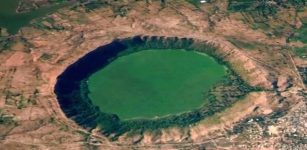Sand Dunes Communicate With Each Other – Beautiful Physics Discovery
Cynthia McKanzie – MessageToEagle.com – Scientists have examined the behavior of sand dunes and made a beautiful physics discovery. Studies show sand dunes actually communicate with each other when they move. They can even repel their downstream neighbors.
It’s not completely unknown to find traces of communication in nature. We have previously seen that trees can talk to each other. Trees support each other with the help of social networks. Scientists call the secret communication of trees Wood Wide Web and just like the term implies, the information exchange resembles the internet.

Credit: Public Domain
To learn more about sand dunes, researchers from the University of Cambridge used an experimental dune ‘racetrack’ and observed that two identical dunes start out close together, but over time they get further and further apart. This interaction is controlled by turbulent swirls from the upstream dune, which push the downstream dune away.
“There are different theories on dune interaction: one is that dunes of different sizes will collide, and keep colliding, until they form one giant dune, although this phenomenon has not yet been observed in nature,” said Karol Bacik, a Ph.D. candidate in Cambridge’s Department of Applied Mathematics and Theoretical Physics, and the paper’s first author.
Another theory is that dunes might collide and exchange mass, sort of like billiard balls bouncing off one another until they are the same size and move at the same speed.
To understand the interaction of sand dunes, scientists designed and constructed a unique experimental facility that enabled them to observe their sand dunes’ long-term behavior.
The two dunes started with the same volume and in the same shape. As the flow began to move across the two dunes, they started moving.
“Since we know that the speed of a dune is related to its height, we expected that the two dunes would move at the same speed,” said Dr. Nathalie Vriend, who led the research in a press statement. “However, this is not what we observed.”
Initially, the front dune moved faster than the back dune, but as the experiment continued, the front dune began to slow down, until the two dunes were moving at almost the same speed.
See also:
10 Fascinating Facts About Plants
Strange Hoodoos – Living Growing Stones – An Incredible Geological Phenomenon
The Old Man Of Crater Lake: Mysterious Tree Trunk That Defies The Laws Of Physics
Crucially, the pattern of flow across the two dunes was observed to be different: the flow is deflected by the front dune, generating ‘swirls’ on the back dune and pushing it away. “The front dune generates the turbulence pattern which we see on the back dune,” said Vriend
“The flow structure behind the front dune is like a wake behind a boat, and affects the properties of the next dune.”
As the experiment continued, the dunes got further and further apart, until they form an equilibrium on opposite sides of the circular flume, remaining 180 degrees apart.
The next step for the research is to find quantitative evidence of large-scale and complex dune migration in deserts, using observations and satellite images. By tracking clusters of dunes over long periods, we can observe whether measures to divert the migration of dunes are effective or not.
Written by Cynthia McKanzie – MessageToEagle.com Staff Writer










